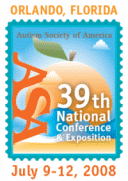 |
The ASA's 39th National Conference on Autism Spectrum Disorders of ASAThe Westin Kierland Resort & Spa, Scottsdale, AZ |
| For a complete author index with session numbers, please click here | |
| Thursday, July 10, 2008: 2:15 PM-3:30 PM | |||
| Miami 1 | |||
| #3539- Prevalence of Adolescents with an ASD in a Criminal Justice Facility | |||
| Autism spectrum disorders are present in increasing numbers within criminal justice settings. In one setting, a formal evaluation was conducted on all adjudicated youth using a variety of psychological instruments to both empirically show the prevalence of a developmental disorder as well as any co-existing disorders, and to suggest and define treatment needs and issues. This workshop will outline both the assessment protocol utilized as well as the implication of the results when attempting to meaningfully address recidivism. | |||
| Presenter: | - Lawrence R. Sutton is a Deacon in the Diocese of Pittsburgh and is a licensed psychologist and Manager of the Western Region of the Bureau of Autism Services in Pittsbugh Pennsylvania. He has worked with individuals with developmental disabilities since 1992. He was Ordained a Deacon in 1999. | ||
|
| |||
|
We have all heard the statistics 1 in 150 children are diagnosed with autism – so unbelievable. That so many children are unable to relate socially, that so many children are unable to communicate in typical way’s with the world, and even more surprising and shocking is the amount of these children who are making their way into the ranks of those in the criminal justice system. Not just the regular criminal justice system but the most serious element of the system, those of the sexual offender. In an unpublished account at a Youth Development Center in Western Pennsylvania in May 2005 it was estimated that 40% of the adolescents in the sexual offenders unit had an autism spectrum disorder. Many were victims of sexual and physical assault themselves prior to their committing offenses. So many frightening questions are raised by these numbers. What is happening to these children in criminal justice centers, have they been identified as autistic, are they separated from other youths who could take advantage of them based on their diagnosis, did the court officers and attorneys know when they were going through the process that they needed special assistance, can they be rehabilitated in a setting that is not specifically designed for autistic individuals? And then, how do we prevent these children from entering the system? What is so shocking about these cases is they are children you and I might likely see every day. These youths are higher functioning autistic kids for the most part, but they did not know how to properly or effectively communicate or in some ways engage with the world in certain ways. They are teens who got confused and may have been taken advantage of by others simply because they wanted to fit in and have some friends. This presentation will focus on a close examination of one adolescent criminal justice center program in Pennsylvania, looking for the presence of an autism spectrum disorder in its residents. In the examination, all “offenders” received a psychological assessment which looked at intelligence, how they processed information auditorally, for the presence of depression and anxiety; for personality disorders; to see if they themselves were abused physically or sexually before they offended and to look for the presence of autism. The program will include a description or story about some of the youth at this program and will conclude with specific treatment recommendations for those ASD youth and young adults in criminal justice centers as well as suggestion on how to prevent and divert placement of ASD youth in criminal justice centers. |
|||
See more of General Submissions
See more of The ASA's 39th National Conference on Autism Spectrum Disorders